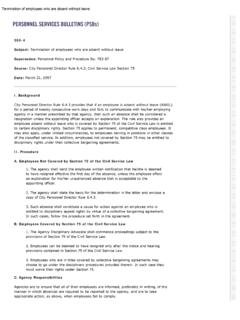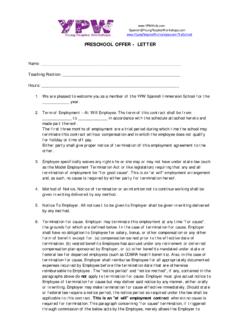Transcription of Termination of Employees in Japan - TransAsia Lawyers
1 - 1 - Termination OF Employees IN Japan : LEGAL CHALLENGES AND BEST PRACTICES Termination of regular Employees is a difficult and unpredictable procedure under Japanese law and practice, and no amount of preparation or planning can completely mitigate the risks the process entails. These risks and unpredictability arise from two peculiarities of Japanese law. The first is the expectation of lifetime employment in Japan , where 'at will' style employment and Termination does not apply. The second is the fact that Japan is a civil law jurisdiction where past judgments cannot be relied upon to ensure the outcome of future findings. The combination of these two factors results in high protections for Employees and largely unpredictable outcomes regarding Termination for Employees in all but the clearest cases.
2 They culminate in what is known as the "principle of appropriateness" which was first defined clearly by the Supreme Court of Japan in 1975: "Even in the case where grounds for regular Termination exist, the Employer may not always be able to terminate. When, in view of the applicable concrete circumstances, effecting Termination is highly unreasonable and unacceptable based on the prevailing attitudes of society, said Termination shall be considered invalid as an abuse of the employer's right to terminate." It is for this reason that Termination should never be approached lightly in Japan , and the approach should always seek to be as conciliatory as possible, regardless of how sure the employer may be of its practical justification for employee Termination .
3 Termination Methods For regular Employees who have been with their employer longer than their probation period (which in Japan is usually three months but no longer than six months) there are generally three available employee Termination methods in Japan : (1) resignation, (2) normal/ordinary dismissal, and (3) disciplinary dismissal. (1) Resignation is based on mutual agreement between the employer and the employee , and resignation can be proposed by the company to the employee . - 2 - 2011 Even when an employee does not emotionally accept discharge from the employer, many Japanese companies compromise financially with the employee such that this person eventually resigns voluntarily. This method is based on mutual agreement, so the compensatory amount paid to the employee in return for voluntary resignation is simply a matter of negotiation and agreement by the parties.
4 As a legal matter, in these cases the employee is effectively agreeing not to exercise his or her rights to claim wrongful Termination (by way of resigning voluntarily) in return for payment of a lump sum, usually comprising a combination of notice/payment in lieu of notice and severance payment. This type of discharge has, obviously, the lowest risk of claim or dispute subsequently arising, and is therefore the ideal method if the parties are reasonable and can reach agreement. In this method where the employee has passed out of his or her probation period, many companies provide three months or more (on average, six months) salary to the employee for an amicable settlement. (2) Normal dismissal is based on Japan 's Civil Code and Labor Standards Law In principle an employer in Japan can freely terminate an employment agreement if the employment satisfies the following conditions provided by the Labor Standards Law (plus anything more which may have been guaranteed to the employee by employment contract, if applicable): where an employer elects to dismiss an employee having a non-fixed term contract, the Labor Standards Law provides that the employer must provide the employee with either 30 days prior notice, or a payment equivalent to 30 days salary.
5 Notwithstanding the above principle, from the viewpoint of protection of workers, Japan has proceeded to legislate that the employer must have "justifiable reason" for dismissing an employee on other than a fixed-term contract. An employer who dismisses a non-fixed term employee without "justifiable reason" risks having the employee 's contract reinstated by the courts. "Justifiable reasons" for Termination have been characterized as follows (with (a) to (c) being required to be quite serious in practice to satisfy the requirement): - 3 - 2011 (a) cases where workers cannot work, lack the ability to perform work properly, or are ineligible for the subject work; (b) cases where workers violate the employer's rules of employment; (c) cases where it is necessary to dismiss workers from the viewpoint of operating the business of the employer; and (d) cases where labor unions request that an employer dismiss an employee based on an applicable union agreement.
6 With respect to item (c), above, the Japanese courts have also established criteria which must be satisfied in order for it to be considered necessary for an employer to dismiss a certain number of Employees from the viewpoint of operating the business, as follows: (a) a "valid need" to implement the dismissal must exist. Such a need may be found where the dismissal is reasonably based on a business slump, decline or recession affecting the employer, or a situation which arguably makes such dismissal otherwise "unavoidable". (b) the employee should only be dismissed as a "last resort" and only after reasonable efforts have been taken to utilize the employee in an alternative manner (for example, by transfer, secondment, temporary furlough, offer of an early retirement package, or obtaining the employee 's consent to the Termination of his/her employment).
7 (c) the employer should use reasonable and objective standards in determining which Employees are to be dismissed. (d) the employer should engage in good faith discussions with Employees who are to be dismissed to explain the basis for the dismissal, the manner in which the dismissal will be implemented, etc. Another significant hurdle when judging these matters is the validity of selection criteria used to choose which Employees should be dismissed. These criteria must be reasonable and objective in the view of a court. It is not always clear, however, where the Court will draw the line as to what is reasonable. - 4 - 2011 The Courts have for example been known to judge the following criteria as acceptable: (a) Selecting Employees who are close to retirement age; (b) Selecting Employees who are often tardy, absent, or leave the office early, and have been repeatedly warned of this to no avail; (c) Selecting Employees who are ranked comparatively poorly compared to their peers in the company (this being difficult to show objectively as a matter of practice), and who have been repeatedly warned of this to no avail.
8 The above examples would be required to be objective from a reasonable societal perspective (not only from the viewpoint of the employer) and clearly evidenced. (3) Disciplinary dismissal is the most severe method to both the employee and the employer. This dismissal still requires 30 days prior notice or payment in lieu thereof (excluding very rare cases of where the employer discharges the employee without prior notice or payment in lieu thereof pursuant to advance approval having been provided by the head of the applicable Labor Standards Inspection Office). Disciplinary dismissal is considered extremely severe and is justified only when, for example, an employee has committed crimes or very serious ethical breaches, made a false statement in his or her resume at the time he or she applied for employment, or had an unreasonable absence (for example, more than two weeks without a reasonable justification therefor).
9 Since disciplinary dismissal is especially disadvantageous for the employee , the threshold by the Court regarding "sufficient reasons" for this type of dismissal is high and its use is rare in usual Termination cases. Best Practices Many foreign parent companies accustomed to 'at will' Termination often initially feel that a significant lump sum payment for amicable separation with Employees is unreasonable, especially where the employee has had performance issues. Given the high protections for Employees in Japan , however, this approach is often the most efficient way to dismiss a regular employee in cases where he or she has moved out of his or her probation period. - 5 - 2011 If the employer opts for unilateral dismissal and the employee contests the dismissal in a Japanese court, the procedures can often continue for many months or even more than a year.
10 This exposes the employer not only to considerable effort and legal expenses to defend the claim, but also opens up the company to additional costs vis- -vis the employee . For example, in the event the dismissal is ruled invalid, the employer will, at a minimum be required to compensate the employee for all back wages which he or she would have received from the time of the purported dismissal until the time of reinstatement. The employer will also be required to return the employee to his or her former post and the employee will at this point have considerable bargaining power to negotiate for a high amount of settlement for agreed separation. When considering from a practical perspective the two main options of resignation (that is, agreed separation) and ordinary dismissal, it is usually preferable to take the route of agreed separation even if the lump sum compensation payment to the employee seems high at the time.







